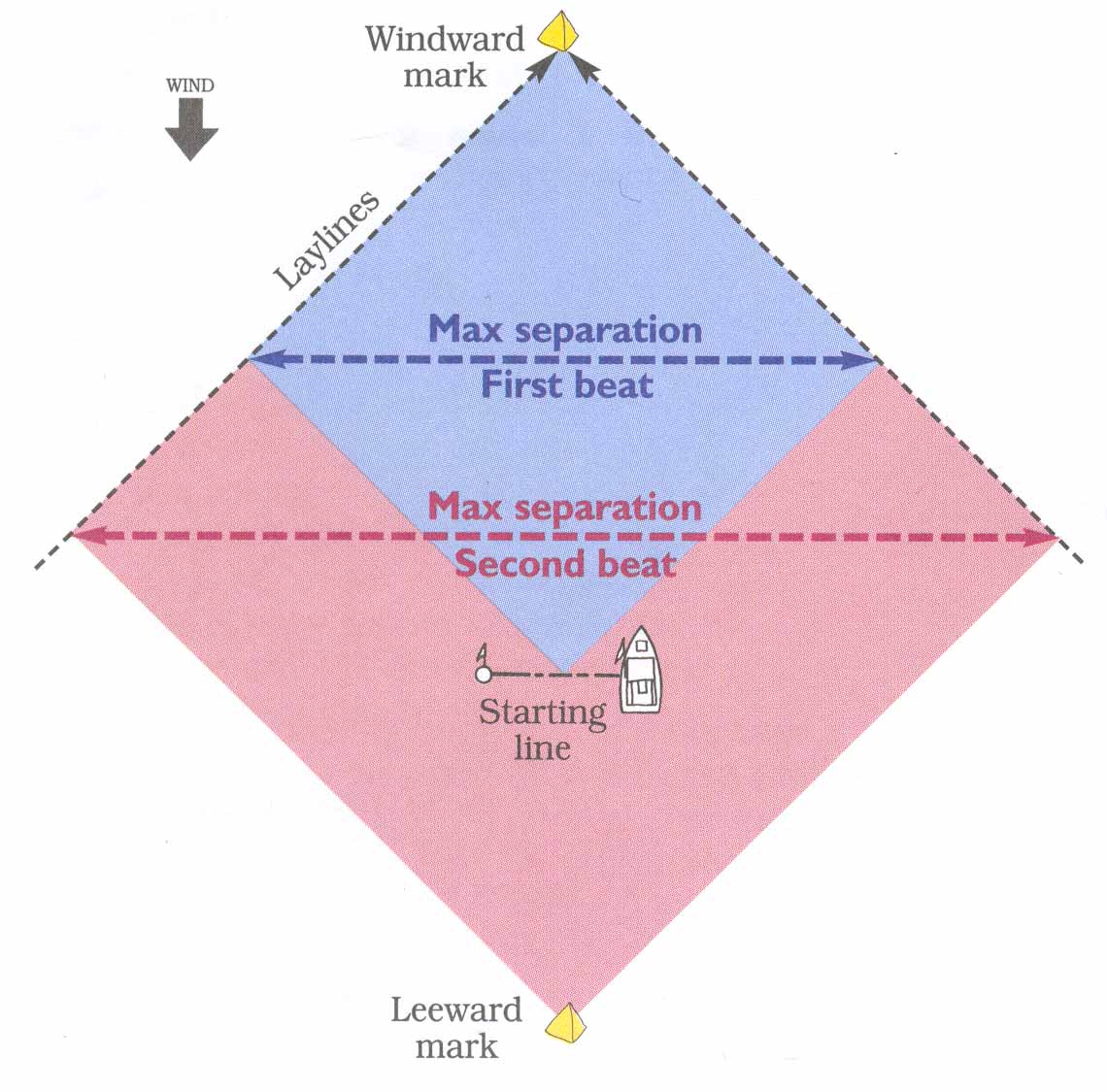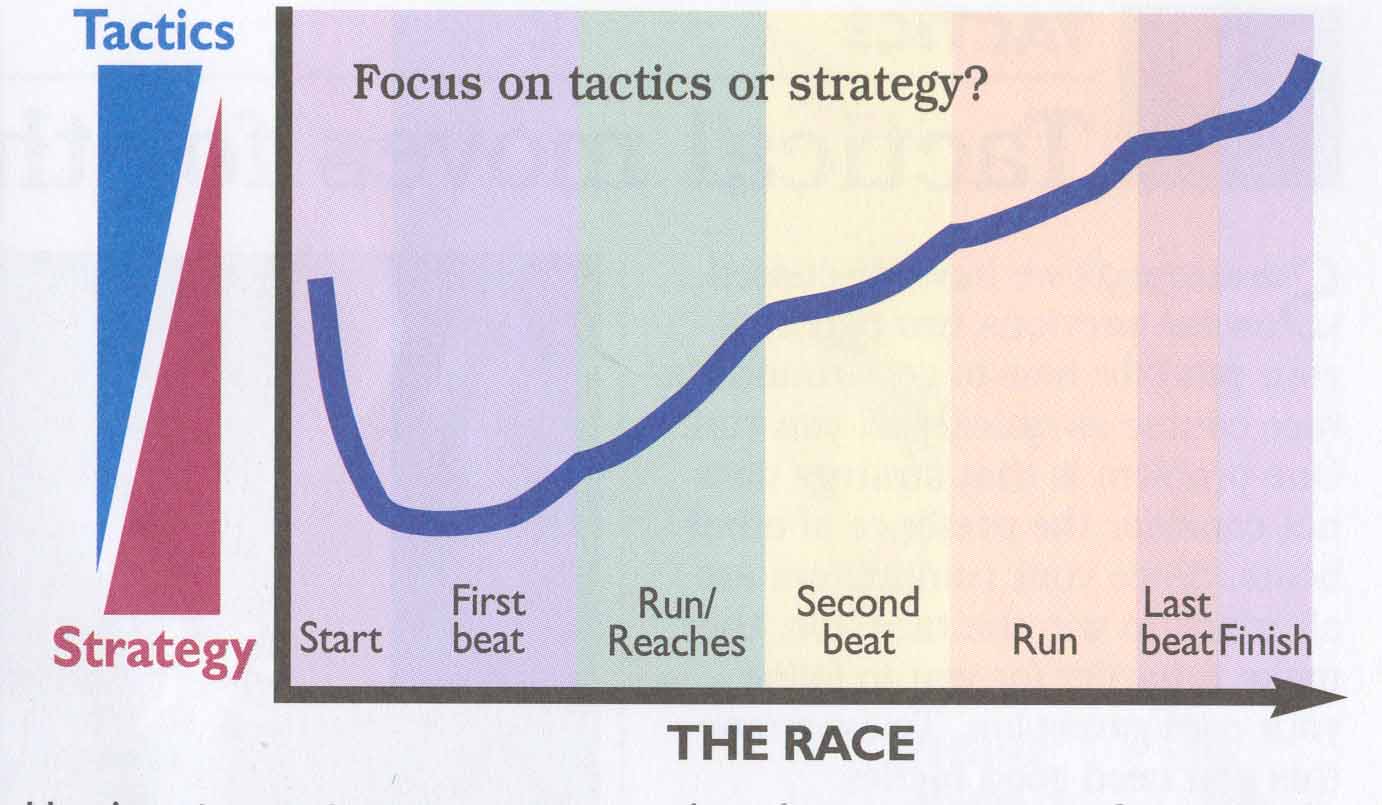Go
For It On The Second Beat!
by David Dellenbaugh
After rounding the leeward mark, you
must be ready to attack the second beat.
This leg is usually critical because
it’s your best chance to catch up when
you’ve fallen behind or to solidify your
lead when you’re ahead. Unfortunately,
many sailors do not even think about the
second beat as a photocopy of the first
beat. But there are many reasons why you
should treat the second beat quite
differently from the first one:
1. The fleet is more spread out. This
means it will be harder to pass (and
harder to lose!) other boats. There also
may be some boats up ahead that you can
watch for windshifts and wind pressure.
2. The second beat is usually longer
because the leeward mark is often set to
leeward of the starting line. This means
the fleet will get farther apart on this
leg. It will be harder to cover, but
also possible to get more “leverage” if
you’re trying to catch up.
3. You are closer to the finish of the
race, which affects the amount of risk
you’re willing to assume in tactics and
strategy.
4. The second beat may be affected by
boats still sailing on the previous
reach to run. This means you must catch
for a different variety of bad air,
disturbed water and potential
obstructions.
5. The wind and water may seem exactly
like they were on the first beat, but
it’s later on the day and conditions are
always changing. So don’t assume
everything is still the same.
Because of all this you must view the
second beat as a unique animal. To be
fast and smart, you need a fresh
perspective on boat-speed, tactics and
strategy.
Try these strategy ideas after the
leeward mark
Strategizing for the second beat is a
lot like planning for any other leg. You
strategy (the plan you make for getting
to the windward mark as quickly as
possible) should be in place before you
round the leeward mark. It doesn’t have
to be too complicated, but it should
consider a number of factors like wind
velocity, wind shifts, current, waves
and the location of the next mark (but
not the presence or actions of your
competitors).
One of the good things about planning
for the second beat is that you can draw
from a lot of recent history. Since you
have been racing for at least the last
half hour, think back on patterns you’ve
been seeing in wind velocity and
directions. What do you do for the next
15 to 20 minutes?
Often you can use information about what
happened on the first beat. If the boats
that were leading at the windward mark
all came from the right side, for
example, the you should probably
consider that side of the second beat
(especially if their gain was due to a
geographic wind effect). You shouldn’t
just blindly bang the right corner,
though, because the wind conditions are
always changing - and maybe the left
side will be favored this time.
You can also use your observations from
the run or reach that you just sailed.
You have to be careful, though, because
it’s usually harder to keep track of
windshifts when you’re going downwind.
Also, sometimes the side of the course
that’s favored on a run will be
unfavored on the next beat. This could
happen for example, when gains are due
to wind direction.
 |
| Because the leeward
mark is often set to
leeward of the starting
line, the second beat is
usually longer than the
first beat. This means
that the “corners” of the
course are farther apart
the second time around,
especially in light air(
when tacking angles are
wider) and for boats that
don’t point especially
high to begin with.
Strategically, this is
challenging because the
fleet tends to spread out
a lot more, and you have
a much wider choice of
where to go. It generally
makes staying ahead more
difficult because it’s
harder to stay close to
the boats behind. On the
other hand, it makes
catching up potentially
easier because it’s not
so hard to get “leverage”
(separation) on the boats
ahead. |
After you collect your thoughts about
the second windward leg, piece together
a mental gameplan. This could be as
simple as
“go left” or “go right.” You just need
to keep you on track as you sail up the
beat.
Let’s say, for example, that you are on
a port tact, converging with a starboard
tacker. You decide to keep clear by
tacking, but as soon as you get on
starboard tack you realize that you are
now headed for the wrong side of the
course. If you had been thinking “go
right” as you approached the other boat,
you could have ducked them and kept
going toward the favored side. Here are
some other tips and ideas about
strategizing on the second beat.
Keep reevaluating your plan.
Remember that the wind and other
variables are always changing. The plan
that you put together before the leeward
mark may no longer be valid when you are
half way up the leg. So keep your heed
out of the boat. One good thing about
the second beat is that the fleet gets
pretty spread out and there are boats
all over the course to help you see
windshifts and identify which side is
paying off.
Besides choosing a side of the course,
you must decide whether you will play
the windshifts as oscillating or
persistent. This is a key part of you
strategy on any leg, especially on the
second beat because it is relatively
long. If you think changes in the wind
direction are oscillating but they are
really persisting, or vice versa, then
you will lose a lot of distance.
Follow basic principles.
There are some strategic rules of thumb
that seem to work every leg- of the
race. These are especially important for
the second beat.
Sail the longer tack first - This is
always number one on my list because it
usually works so well. By sailing on the
tack where your bow is pointed closer to
the windward mark, you’ll stay away from
more corners of the course. More
important, you will increase your odds
of benefitting from the next windshift,
especially when you’re not sure which
way it will go.
Stay away from laylines - This is a
really good corollary of the principle
above because you won’t get to a layline
if you sail the longer tack. Laylines
are usually bad because once you get
there you can’t play the shifts any more
, and other boats may tack on you. Of
course, you can’t avoid the laylines
forever (or you’ll never get to the
mark) - just try not to spend too much
time on your final approach.
 |
| Here’s an interesting way
to compare the relative
importance of tactics and
strategy during the course of
a race. OK, this is grossly
oversimplified. But the point
is that, except for the start
and mark roundings, you should
usually focus more on strategy
early in a race and more on
tactics later in the race. |
Sail toward the next shift - If you can
figure out where the wind will shift
next, just sail in that direction and
you will end up on a higher ladder rung.
This works for both shifty and
persistent winds.
Consider risk factors.
It’s hard to think about strategy
without also considering the level of
risks you’re willing to assume during
the leg you are planning. For example,
if you decide you like the right side of
the second beat, does this mean you will
go all the way into the right-hand
corner, or just slightly to the right
side of the rhumbline? Your answer
depends on a number of different factors
including your current position in the
race and the overall series.
Plan for the windward mark.
A big part of any second beat is making
a good approach to the second windward
mark. You often sail a run after this
leg, so here are some things you should
do:
1. Locate the leeward mark visually
before you round the windward mark.
Which jibe looks longer? Will you be
able to fetch the leeward mark on either
jibe?
2. Plan a strategy for the run. What is
happening with the wind pressure and
direction, and the current? Do you like
the left side or the right (looking
downwind)?
3. Decide on a bearaway set or a jibe
set. This depends on many factors like
the wind velocity (don’t jibe set in
light air), favored side of the course,
and the longer jibe. Another
consideration is the side on which you
have your spinnaker. If it’s on the port
side and you will round the mark to
port, you may have to do a bearaway set
unless you are able to move the chute to
the other side before the mark. Also, if
you are planning to do a jibe set, make
your approach to the mark on starboard
tack since a tack-jibe-set is usually
slow.
Dave publishes the newsletter Speed &
Smarts. For a subscription call:
800-356-2200 or go to
www.speedandsmarts.com

